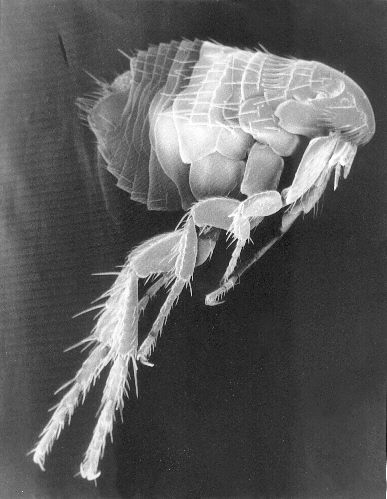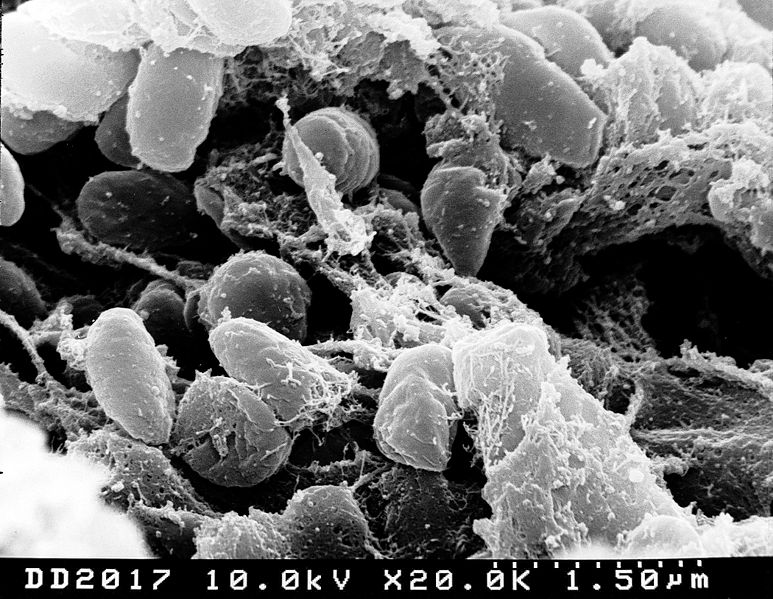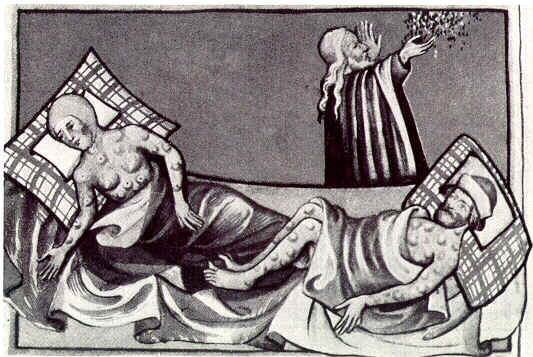| P. s. pv. tomato DC3000 | P. s. pv.phaseolicola 1448A | |||
|
Module
1 - Social Science Issue Bubonic Plague |
||||
|
Additional Resources: Student
Resources |
Glossary
of Terms (for CAPITALIZED words) |
| The Bubonic Plague | ||||
| Throughout history, bacteria have caused many devastating diseases in both plants and animals. A famous example is bubonic plague, caused by a bacterium with some surprising similarities to Pseudomonas syringae | ||||
Yersinia pestis and the Bubonic Plague
The Black Death
Learn moreIn the introduction to Module 1 - Lab you have learned that Pseudomonas syringae uses a special apparatus to infect plant cells. This molecular machinery, called TYPE III SECRETION SYSTEM, is the same that the bacterium Yersinia pestis uses to infect animal cells. Y. pestis is responsible for the deadly disease named bubonic plague and is particularly famous because it was responsible for the terrible pandemic that happened in Europe in the mid-14th century killing millions of people.
Yersinia pestis and the bubonic plagueThe primary host of Yersinia pestis is not humans; it is the oriental rat flea named Xenopsylla cheopis. Human get infected when they are bitten by an infected flea.
Scanning Electron Micrograph of a Flea
Source: Wikipedia (link to picture)
Scanning electron micrograph depicting a mass of Yersinia pestis bacteria in the gut of the flea
Credit: Rocky Mountain Laboratories, NIAID, NIH
Source : Wikipedia (link to picture)As suggested by its name, the usual host of the rat flea is not humans; it is rats. But rats are not immune to the plague and they die about six days after infection. Thus an outbreak of bubonic plague in a flea population will cause a rapid decline in the rat population. With their supply of food (ie. blood from rats) diminishing, the hungry fleas are forced to look for a new host. This can be any mammal, and is often humans, since rats and humans often live in close proximity. Other rodent species like prairie dogs, wood rats, chipmunks can be a source of human infection and pets are also a potential source of infection. When the infection evolves to the more virulent form of plague named Pneumonic plague, people can become sick by inhalation of bacteria-containing-droplets exhaled by coughing by infected animal or humans.
The effects of the bubonic plague on the human body are both rapid and drastic. Initial symptoms include fever, chills, headache, and extreme exhaustion. The lymph glands swell to form egg-shaped lumps under the skin. These swollen glands are called bubos, and are the origin of the plague's name.
If the disease is not treated, the bacteria will enter the blood and multiply rapidly. Bacterial infection of the lungs and other organs can lead to a rapid death of the victim. According to the Centers for Disease Control and Prevention, 14% (or 1 in 7) of the plague cases in the United States are fatal. Hopefully, when diagnosed early enough, the bubonic plague responds well to treatment with antibiotics.
In the mid 1300's, a disease, referred to as the Black Death, devastated Europe and killed approximately 35 million people between 1348 and 1350 (between 1/4 and 1/3 of the total population of Europe at the time).
Illustration of the Black Death from the Toggenburg Bible(1411)
Source: Wikipedia (link to picture)What causes the Black Death? In the 1300's there was no real understanding of microorganisms and the people of the time had many explanations for the plague, trying to explain the misery around them. Some believed that the disease was caused by an inauspicious alignment of the stars, while others felt it was caused by toxic gases released from the earth. Many felt that the plague was a punishment from God, for sins ranging form a lack of piety, excessive greed, or even for immodest clothing.
Today, many scientists and historians think that the Black Death was very probably a bubonic plague pandemic caused by the bacteria Yersina pestis and actively spread through the high population of rats living in close proximity with humans in the Middle Ages.
The bubonic plague is thought to have entered Europe through the city of Caffa. A trading settlement along the black sea set up by Italian merchants from Genoa, Caffa was a walled city used as a way station in the shipping of goods from Asia to Europe. In 1346, disagreements between the Italian merchants and the local Turkish population, known as the Tartars, escalated into violence. The Italians were forced to retreat within the walls of Caffa, and the Tartars laid siege to the settlement. The siege had for a number of days and the Italians were running low on supplies. Suddenly, the besieging army was thrown into disarray. The plague had broken out in the Tartar army! It ran rife through the Tartar camp, killing thousands of troops a day. With the majority of his men ill or dead, the Tartar commander was forced to withdraw.
The Tartar commander was not willing to give up entirely, though. Before withdrawing, the he ordered that the corpses of plague victims be catapulted into the city. Even though the Italians burned or buried them as quickly as they could, but it was no use. The plague spread rapidly through Caffa. Many historians think now that during the siege of Caffa, plague was brought within the walls by the movement of rats, rather than the catapulting of corpses.
In an attempt to escape, the Italians fled by sea back to Genoa. The Italians were able to escape from the Tartar's, but not from the disease. The ships that arrived in Genoa were filled with the dead and dying. When the residents of Genoa realized what was wrong with the ships they either drove the ships off or set them alight. The damage had been done, though, and soon the plague had Genoa in its grip. People fleeing by boat from the plague in Genoa actually spread it up and down the Italian coast. By the end of 1347, the movements of merchants and refugees had spread the plague spread much further, reaching through France, Spain, and Greece. By 1350, it had even spread the way to England, Ireland, and Sweden.
To learn more...
To learn more about the bubonic plague, consult the following fact sheet at the Centers for Disease Control and Prevention (CDC).
Pictures of Yersinia pestis, fleas and disease symptoms are available through this page of the CDC website.
To learn more about the Black Death consult Wikipedia Black Death page and the plague page at The Virtual Museum of Bacteria.To learn more about the Seige of Caffa, see the following historical review published in Emerging Infectious Diseases



